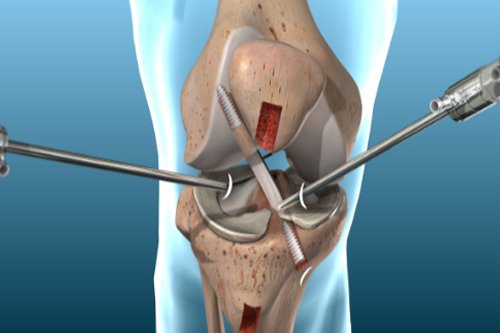
Dr. Sanjay Barik
Knee & Shoulder Surgeon
Meet Our Doctor

Dr. Sanjay Barik
Orthopedic and Joint Replacement Surgeon
Dr. Barik's Orthocare Clinic
- MBBS
- MS - Orthopaedics
ACL Surgery With Internal Brace In Khandwa
- Home
- Quick Links
- ACL Surgery With Internal Brace In Shahdol
An ACL injury is a tear or sprain of the anterior one of the strong bands of tissue that help connect your thigh bone (femur) to your shinbone (tibia). ACL injuries most of the commonly occur due to the during sports that involve sudden and quick stops or changes in direction, jumping and landing such as soccer, basketball, football and downhill skiing.
Many people hear a pop or feel a popping sensation that includes in the knee when an ACL injury occurs. Your knee may be swell, feel unstable and become too painful to bear weight. Depending on the severity of your ACL injury, treatment may include rest and rehabilitation exercises to help you regain strength and stability, or surgery to replace the torn ligament followed by the rehabilitation. A proper training program may help to reduce the risk of an ACL injury.

How does internal bracing work?
We perform to the internal bracing and the ACL surgery procedure on to patients under the anesthesia first. We can either take a donor tendon from a cadaver a deceased donor or from the patient’s own body. Then, we drill tunnels into the bones of the knee, so that once the repair or replacement is complete, We are insert the internal brace with the ligament, so it follows the same path and receives the same force as the new ligament.
Think of it as sort of a temporary ACL while the new ACL gets stronger.In the past, where the ACL stopped and started within the knee was not well understood or mapped. In fact, currently the most common reason for revision ACL surgery is incorrect original tunnel placement. Rehabilitation also took much longer.We commonly see patients who had ACL surgery years ago, and we unfortunately have to operate again because they don’t have adequate range of motion or stability. What we know for all therapies is that if you go into a surgery with poor motion, you typically will have poor motion afterward. But all the research that’s come under during the last decade about understanding where the ACL starts and where it goes, coupled with the evolution of minimally invasive ways to incorporate new technologies, have combined to allow us to perform more effective, lasting repairs.
Symptoms
symptoms of an ACL injury includes are:
- The loud popping sensation in the knee
- Severe pain and the inability to continue activity
- Rapid swelling
- Loss of range of motion
- A feeling of instability or giving way with the weight bearing
Treatment Options
The Most ligament injuries can initially be cared for by applying the “RICE” method:
- Rest: Take a break from strenuous physical activity, including activities that causes a pain or discomfort. to Find things that don’t cause pain but keep you on the move.
- Ice: Use an ice pack for 15-20 minutes, and repeat every one to two hours to reduce pain and swelling.
- Compression: The Wrap an elastic bandage around the injury, taking care not to wrap the injury too tightly.
- Elevation: Elevate your injured joint above your heart to reduce swelling.
Treatment for ACL Surgery
If you have a mild range of ligament tear, like a minor ankle sprain, you may able to treat it at home. Orthopedic doctors often recommend to the (RICE) therapy protocol rest, ice, compression, elevation.
After surgery or immobilization, you may require physical therapy or rehabilitation to get back to your condition. you shouldn’t take them lightly. Make sure to see your doctor right away if the pain and swelling don’t decrease within you cannot bear any weight on the affected body part, or your symptoms get worse.
InternalBracing for Patellar Dislocation
dislocation is a frequent problem, but 75% can be corrected by proximal soft tissue realignment. If the tissues are not considered adequate, then hamstrings are often harvested as formal femoral reconstruction is carried out. This causes donor site morbidity and also places dead tissue over the ligament which has to be protected during its period .
This can result in irritation, muscle wasting, and wound complications.The Internal Brace can provide an attractive alternative for borderline cases as the soft tissue which has been injured is still present and a similar model to the Brace repair of the ankle can be tension and re-applied to the patella using bone to soft tissue fixation. This, of course, is insufficiently strong to allow early but the Internal Brace does protect the repair, preventing attenuation during early .
It provides a low-profile augment without the donor site concerns.Tissue balancing, however, has to be carried out first of all with the Internally simply on top, with the proximal stand secured on extension and more distal component of the flexion. This can allow as soon as satisfactory quadriceps control is restored.


